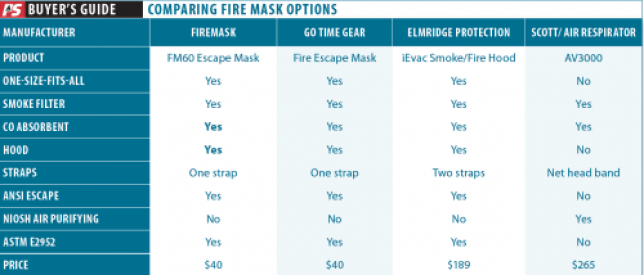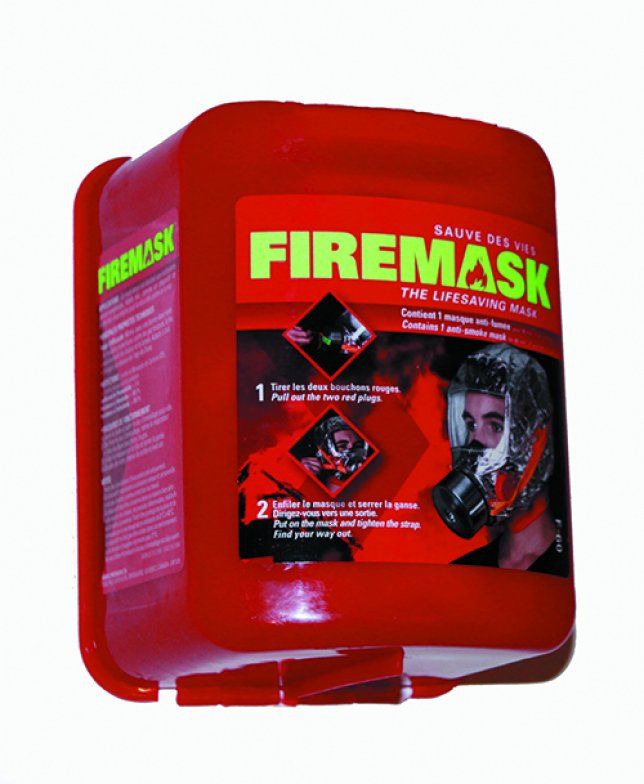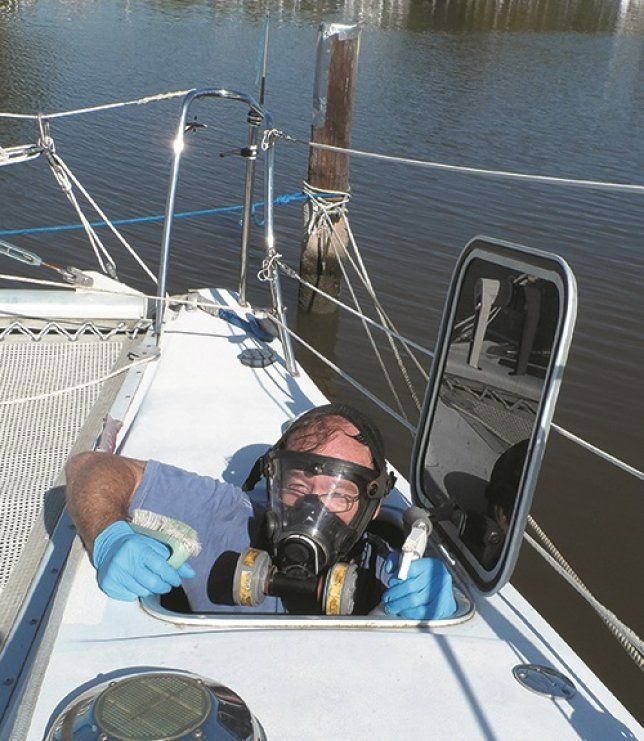In case of fire, obviously there are times when quick retreat is the only plan. If gasoline, propane, or even a can of WD-40 is likely to become involved, you need to go. Fiberglass ignites fast, so only incipient fires are worth fighting. Of course, if you are sailing and aware, this is the only sort of fire you should face. Thus, assuming the engine is diesel and the propane is shut off at the tank, which is also some distance away, you have a few minutes.
A key problem is that a confined space, like a cabin, rapidly becomes filled with smoke. After you fire off a fire extinguisher, breathing becomes impossible and your eyes are irritated beyond practical use within seconds. And yet you still need to investigate whether the fire is truly out and maybe do a little mop-up of embers with water. Or perhaps the challenge is your hands. You have burning cushions you need to grab and throw overboard, or interior woodwork that need to be ripped apart.
Although firefighting apparel is impractical in terms of space, training, expense, and donning time, perhaps the respirator we use in the boatyard and a good pair of gloves are sufficient to do what is needed. However, remember that nothing discussed in this article is about real firefighting. A pair of gloves and an escape respirator is not turnout gear and you probably don’t have firefighter training. None of the respirators in this review are rated for oxygen-deficient atmospheres, none for high levels of carbon monoxide, and burning plastics put off highly toxic fumes.
We haven’t tested any of this gear in burning boats, but we do know a few things from industrial and refinery experience. Number one: You must have a clear escape route and leave in time.
Observations
Escape Hoods. OSHA does not require escape hoods for workers other than in specific high-risk chemical plant settings. However, if escape hoods are present in the workplace, training is required. At first blush this seems like overreaching-after all, they are not required and the employer placed them strictly because it seemed like a good idea. However, if a person is not familiar with the hood, and worse, in a state of panic, they will take too long to don the hood, put it on incorrectly, and perhaps believe that it provides enough protection to linger.
FEMA did a round of testing three different hood types in 2007 (www.usfa.fema.gov/downloads/pdf/escape-mask-evaluation.pdf). They gave the testers 30 seconds to read the instructions, and even so, testers were unable to don any of the hoods in the required time (30 seconds). Clearly, you will need to practice. Even when donned correctly, poor fit allowed too much smoke to bypass the filter in several cases. As a result of this study, escape masks have evolved into just a few, much better fitting designs. But practice is still vital.
Air Purifying Respirators (half face or full face). OSHA has discussed these in the context of fire escape and found both strengths and weaknesses. Unlike escape hoods, these are not one-size-fits-all and it takes a few minutes to adjust an unfamiliar mask. Its best to assume that if it is not your personal mask, it wont fit. Unless you are also wearing goggles, half-masks that cover only the mouth and nose aren’t much use. Dry chemical fire extinguisher dust is hard on the eyes and being able to see is key. A full-face mask gives better protection.
Use multi-gas cartridges and keep them installed in the mask to save time, and store the mask in a gallon freezer bag to prevent the cartridges from absorbing gasses from the atmosphere and going bad before you need them. If these conditions are met, a full-face mask will provide the best protection you are likely to get on a boat, the result of a good seal and good eye protection. They do not provide head protection, but the fact that your ears are still exposed is sort of a good thing; if they begin to burn, its time to get out fast.
Fire Escape hoods must meet CE standard EN 403:2004 (Respiratory Protective Devices for Self-rescue) and ASTM E2952-14 (Standard Specification for Air-Purifying Respiratory Protective Smoke Escape Devices). Full face air purifying respirators equipped with appropriate multi-gas cartridges (HEPA, CO, organics, acid gases) meet the eye and respiratory protection standards, but do not meet requirements for fast one-size-fits-all donning or protection of the head from radiant heat or drips of melted plastic (smoke escape devices must be hooded).
Gloves
Some of the kits come with gloves. Certainly these are an aid to turning hot doorknobs while escaping a building. But we envision a more heavy duty use. Oven mitts seem a logical answer, but there are reasons leather wins out:
- You may have to rip cabinets etc. If so, you’ll need something strong and durable with good grip.
- The gloves must repel liquid because you may have to grab some thing that is wet. We know from experience that steam and hot liquids shoots right through knit gloves, no matter how well they are insulated.
- Convenient storage. Stellar features don’t matter if your safety gear is stored at the bottom of a locker with your tools. These things must be immediately accessible. We keep ours with our safety harnesses, lanyards, and MOB recovery tools.
Bottom line:Heavy leather work gloves are good thing to have on a boat anyway.

Firemask FM60
Consisting of an aluminized hood, clear face plate, and filter cartridge, the FM60 is said to protect against CO for up to 60 minutes. In higher concentrations of CO, this period can be much shorter, however.

Go time Gear Fire escape Mask
Similar to the FM60, Go Time Gears mask includes a heat resistant hood, visor, and filter. An adjustable elastic band secure the inner mask over your nose and mouth, and thin elastic in the hood seals the neck.
iEvac Smoke/Fire Hood
Using a clear hood, the hood from Elmridge has two elastic bands instead of one, and twin cartridges, this is a more expensive option providing better fit and easier breathing, but slightly longer donning time. Weve trained with these. They are common in refinery settings. Currently, this is the only mask certified to the ASTM E2952 standard for single-use escape masks.
AV 3000
Made by Scott, this is our favorite air purifying respirator for boatyard work, because of comfort, but also because the net head band allows us to put it on and adjust it within 10 seconds. Small wonder the design is very popular with firefighters (they use a high temperature variant attached to an air tank). It must be fitted with multi-gas cartridge that includes protection against carbon monoxide.
Conclusions
If you have a full-face respirator, OSHA says it gives better respiratory protection, and if it is pre-adjusted to fit your face, you should be able to don it in moments. Thee do not provide the head protection of a hood, but we see their primary purpose for boaters as protection from fire extinguisher discharge and plastic smoke fumes. If there is enough heat for that to be a concern, the fire has blossomed beyond fighting, and its time to go. Every boat should have a few pairs of heavy work gloves, so keep one pair with the emergency gear.
Is it worth getting a $250-plus respirator if you don’t otherwise need one? What about a $40 fire hood? It depends on the size and complexity of the boat and the remoteness of your travels. Technical editor Drew Frye once experienced a stubborn electrical fire offshore, and it opened his eyes to the very real risks involved. You look at fire differently when you can’t see land and help isn’t coming. Prevention is smart, but in his case the cause was a bit of wiring tucked under a glued liner that no practical inspection could have revealed.
Finally, remember to keep low. Heat and smoke rises, and often good air remains a foot above the floor, even while the ceiling is on fire and the temperature at standing height is lethal.








































